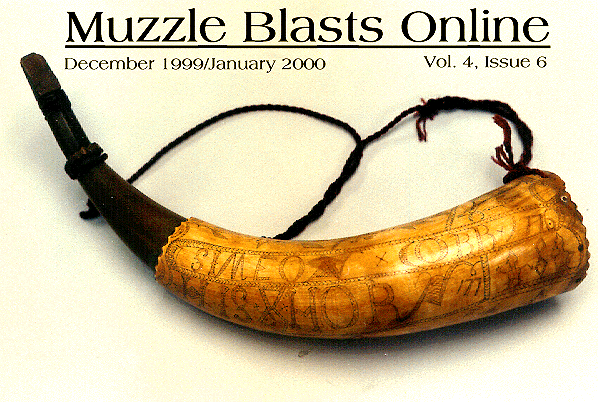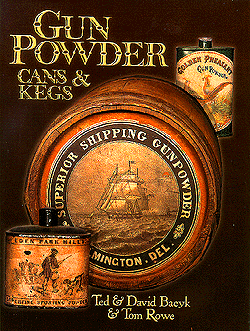|
Muzzle Blasts Online |
|
...for the muzzleloading enthusiast |
|
The muzzleblasts.com domain, subdomains, content, etc., are neither affiliated with the NMLRA nor its paper magazine Muzzle Blasts |
|
Muzzle Blasts Online |

|
|
|
|
|
|
Book Review:
Gun Powder Cans & Kegs
By Ted and David Bayck and Tom Rowe

|
Ted lives in Massachusetts near the Connecticut border, presumably in order to scurry across on short notice. Tom lives in Tennessee, close to the Kentucky border, presumably for the same reason. I live in Kentucky, near the borders with both Indiana and Ohio. Maybe that puts me in a good position to become a collector!
The book's title pretty well gives you a clue to the contents. I say a clue, because in no way are you ready to believe that there were so many different powder packages put out by any one company. In addition, this book shows the fruits of powder mills that most of us have never heard of. That these comprise just a percentage of Ted's collection staggers the mind!
The book was primarily written for collectors. It depicts, in living color, the items illustrated. Most of the photography was done by Tom Rowe. Generally, the collection and information were provided by the two Baycks, and Rowe provided the photography, graphic design, layout, and all the rest of the things necessary to put a book onto the market. Ted's wife Mary Ann also deserves mention; I doubt such a collection as this could have been assembled without support from her.
The entire book is in color. In addition to the fine illustrations, each entry is dimensioned. The capacity in pounds of each can or keg is also listed. Estimated production dates are provided, and the relative rarity is listed on a scale of 1 through 8, along with value in dollars and any appropriate notes.
Here is the key to the rarity scale as presented in the foreword to the book: 1) Very common; 2) Common; 3) Uncommon; 4) Scarce; 5) Rare; 6) Very rare; 7) Possibly one of a kind; 8) Cans to kill for: trip your best friend, pay any price - your wife will understand!
While the above is very useful, the authors do not divulge their real secrets. That is to say, when a friend and fellow collector dies, when to approach the grieving spouse - remembering that there are a plethora of fellow collectors struggling with the same dilemma. Will one of those disrespectful louts get there five minutes before you do?
The above does not imply that dealing with widows is a prerequisite for collecting, for I know of some women who are avid collectors.
The authors have arranged their illustrations in sections by maker. Each section is introduced by using information gleaned from that wonderful source, History of the Explosives Industry in America by Van Gelder and Schlatter, published in 1927. The above reference has been treasured by many of us over the years. This book was prepared from data collected by and published under the direction of the Institute of Makers of Explosives. History of the Explosives Industry in America is a thick book containing over 1100 pages.
Represented in the book Gunpowder Cans & Kegs are the products of the following companies as taken from the Table of Contents:
|
|
The typical format is to show two items, cans or kegs, on each page. The vertical format pages are eight-and-a-half by eleven inches in size. This allows you to read nearly any print on the labels that is legible on the original.
The authors explain that value is not just a matter of rarity. The color, graphics, and association to other collectable or interesting items all enter in. While the values given are somewhat subjective, they are based on many years' experience in collecting. The authors disclaim any responsibility for the use you may decide to make of these valuations. So do Muzzle Blasts and I.
The book addresses the issue of fakes. Where items become as valuable as some cans, kegs, and paper work, there is the temptation to pass off copies as originals.
I would like to say that rarity is often regional. I would not expect to find many early California cans in Ohio, for instance. Later, when transportation got better, cans can be expected to be scattered more widely.
Having said the above, I am amazed to see so many Ohio cans that came from the east coast. At least I assume that most of said cans were collected there. I am writing a book on King's Great Western Powder Company and the King Powder Company, both located twenty-five miles from Cincinnati, Ohio. I have been looking for King material for twenty-five years. There are King items in Ted's collection and in this book, which I have never seen! When my book is published, some of these cans and kegs can be dated a little more precisely.
There are very few King cans and kegs that are not depicted in the Bayck/Rowe book. They may be in Ted's collection, but they don't appear in this first volume.
There is one small error on page 180. In the notes on Frontier Mills, it says that Frontier was later incorporated into the King Powder Company. It was not. King left Miami Powder Company of Xenia, Ohio (which owned the name Frontier Mills) and started King's Great Western Powder Company later in Kings Mills. The Frontier name, if it was still being used, stayed behind in Xenia.
One more comment on accuracy. On page 33, the authors show a four-pound powder can of the American Powder Mills of Boston. They show both sides of this can. Their notes say: "We find the back of the can even more interesting than the front". On one side of the can is the head of a horse. On the other side is the picture of a very outstanding young lady. It is my opinion that they did not know which was the front of the can!
In addition to cans and kegs, the authors show advertising art work as it survives in posters. Most of these are very rare indeed, and the prices shown reflect both the rarity and desirability of the items. The one from King's Great Western Powder Company on page 198 would look very nice on my wall.
The authors also include a map showing the layout of the Hazard Powder Company Works, and with it they publish, for the first time as far as I know, a history of Hazard written by Richard Hazard. The map was from the same source.
While most of the gun powder cans and kegs shown contained black powder, there are some that contained smokeless powder. None of the cans or kegs shown have been in commercial circulation for many years. They also show tins and kegs of King Powder Company's famous Semi-Smokeless Powder, which was unique when introduced in 1896, and for a number of years following.
This is a handsome book. As I said up front, you do not have to be a collector to enjoy the book or profit by it. Anyone with an appreciation for the part that firearms played in our history will enjoy the visual feast the graphics provide. The histories of the mills contained in this volume are short but interesting. Whether you are a collector or simply a browser, this book could allow you to regain several times its price by identifying a bargain at a garage sale or a gun show.
The book is hard bound with an attractive dust jacket. It has 268 pages and includes a brief but adequate index. It is available from Rowe Publications, 295 E. Lake Breeze Pk., Rochester, NY 14622. Price is $65 post paid.